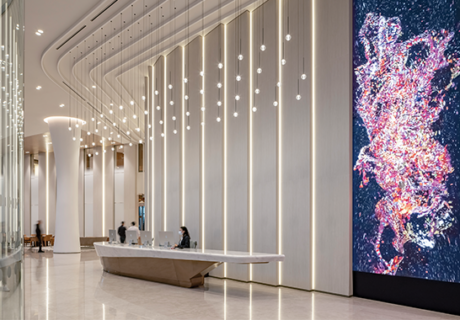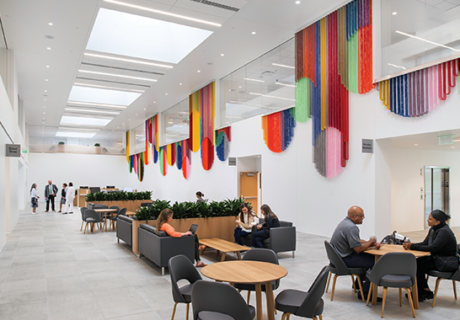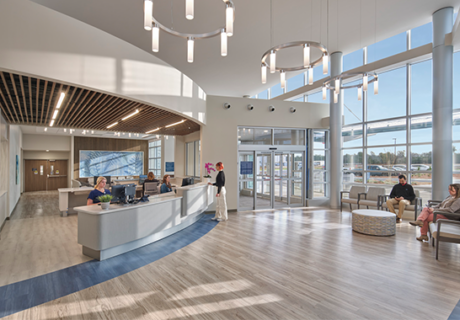Best Of 2014: PHOTO TOUR: Fontana Medical Center
This article was originally published on Feb. 28, 2014, and is among Healthcare Design‘s Top 10 most-read articles of 2014. To see a full list, click here.
Using Kaiser Permanente‘s template system, the new 490,000-square-foot, seven-story hospital and bed tower for the Fontana Medical Center replaces the existing main hospital building, some of which will be converted for outpatient use. The concept for this new 314-bed hospital is based on sustainable architecture designed to holistically support a variety of specialty services. These include a cardiac surgery department, a 24-hour ED with 51 private rooms, pediatric and neonatal ICU, an inpatient dialysis unit, pediatrics, an intensive care unit, labor and delivery, a cardiac cath lab, and surgery.
HMC Architects’ design team executed functional and space programming, with an extensive redesign of the template hospital diagnostic and treatment block. The design optimizes the template hospital with a layer of enhancing patient experiences, improving pedestrian circulation and wayfinding and increases efficiency and capacity within the current template footprint.
The design concept embraces Kaiser Permanente’s Total Health Environment throughout three stages of the patient experience: anticipation, transition, and healing. As patients and visitors approach the building, the gentle curves of the entry function as intuitive wayfinding. Inside the hospital, warm colors activate the space and cues from nature present a welcoming patient experience.
The facility had the need for 51 emergency department rooms—however, the existing Kaiser Permanente template was designed with 28 rooms. Through a series of meetings with Fontana Medical Center staff and Kaiser Permanente’s National Facilities Services division, the design team redesigned the first-floor diagnostic and treatment block, composed of the ED and imaging department. Reconfiguring the ED from “neighborhoods” to an “avenues and streets” model allows for better segregation of patient acuity in the four streets, while allowing for more efficient patient and staff flow between the street along the main circulation path, or avenue.
As Kaiser Permanente shifts from a traditional open nursery concept to private rooms, the design team developed a 28-private-bed NICU inside the template footprint to provide more privacy for families who may be spending long hours with their babies. This is the first time this concept has been implemented for Kaiser Permanente. In addition, an extra stop was added to the sterile elevator to reach the labor and delivery C-section operating rooms. This increases patient safety by allowing sterile instruments and equipment to be delivered directly to a clean core behind the operating rooms. This is important because Fontana Medical Center receives a high number of high-risk pregnancies.
McCarthy Building Cos., HMC, and key subcontractors utilized a design-assist delivery method to expedite the development of project design documents—resulting in the project being completed four months ahead of schedule and more than $35 million under budget. Construction was completed in March 2013 and the medical center began accepting patients in May 2013.
Project Team:
- Kaiser Permanente
- HMC Architects
- McCarthy Building Cos.
- Ted Jacob Engineering Group
- Saiful/Bouquet Engineers
- RBF Consulting
- RHA Landscape Architects-Planners Inc.




